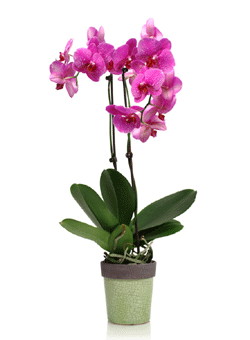
You’ve taken care to select a beautiful, healthy orchid for your home. You’ve started your orchid care routine, and things are looking good. But when you go to water your orchid on its next scheduled watering day, you notice what looks like a coating of fuzzy white mold on the top of its roots or the potting media. What gives? Is your orchid moldy? Growing some other kind of fungus?
Let’s explore this fairly common problem. Here’s what you need to know about Phalaenopsis orchids and mold:
Fungi often enters the orchid through damage on a leaf or the stem. If left unchecked, a fungus can spread down to the roots. So it’s important to inspect your plant for any signs of damage and address them.
It might not be mold: White substance on the orchid potting media
The appearance of a white substance on top of the orchid’s potting media can mean several things.
It can mean it has been overwatered or it does not have enough air circulation.
Another cause of white substances on the potting media could be the use of tap water, which can leave minerals and other residues behind. If you’re using tap water to water your orchid, try using distilled water that has had impurities removed.
What to do: To remedy this, stop watering your orchid until the roots are grayish or white in color. Once this has happened, resume your normal watering schedule.
If you do notice mold on your plant, it is harmless. One way to combat this is to make sure your orchid has enough air circulation. During the summer, you can simply open the windows for adequate air circulation. During the colder months, just turn a fan on low to circulate the air. If you’ve repotted your plant, make sure you don’t use a moss media as this type of media can hold excess water.
If you notice what looks like fluffy cotton blobs on the leaves of your orchid, these are likely mealybugs and not mold. Mealybugs are small white wingless insects that feed on the plant’s tissue. They also produce a sticky substance, so your plant’s leaves will feel tacky.
What to do: If you discover mealybugs on your orchid, isolate it from other plants and spray it with a horticultural oil, insecticidal soap or isopropyl alcohol. Because of their tiny size, it is easy for mealybugs to hide in crevices and other unnoticeable areas. If you have other plants in the house, be sure to check their trays, lips of pots and leaves to ensure they are free of the pests.
Take particular care to spray the horticultural oil or insecticidal soap in folds, branch bases or midrib areas of your orchid. If you’re using isopropyl alcohol instead, you will need to rub the leaves and any other areas where you find mealybugs with a cotton swab or cotton ball dipped in the alcohol. While the initial alcohol treatment will remove the hatched mealybugs, you’ll need to do a follow up treatment to remove any that haven’t hatched. Just hatched mealybugs will appear as tiny yellowish spots.
It’s important to note that heavy mealybug infestations can do serious damage to an orchid. If you notice your plant is showing signs of decline from an infestation despite treatment, it may be time to consider discarding it and purchasing a new orchid.
The appearance of what looks like mold on an orchid can have many causes. When evaluating your orchid, keep in mind actual mold on the surface of your plant will not harm it and there are several causes.

Copyright Just Add Ice® Orchids 2023